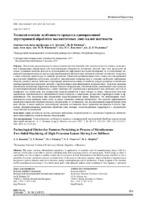| dc.contributor.author | Козерук, А. С. | ru |
| dc.contributor.author | Филонов, И. П. | ru |
| dc.contributor.author | Филонова, М. И. | ru |
| dc.contributor.author | Власовец, Н. С. | ru |
| dc.contributor.author | Мальпика, Д. Л. | ru |
| dc.coverage.spatial | Минск | ru |
| dc.date.accessioned | 2017-05-29T11:06:03Z | |
| dc.date.available | 2017-05-29T11:06:03Z | |
| dc.date.issued | 2017 | |
| dc.identifier.citation | Технологические особенности процесса одновременной двусторонней обработки высокоточных линз малой жесткости = Technological Distinctive Features Pertaining to Process of Simultaneous Two-Sided Machining of High-Precesion Lenses Having Low Stiffness / А. С. Козерук и др. // Наука и техника. – 2017. – № 3. - С. 215-224. | ru |
| dc.identifier.uri | https://rep.bntu.by/handle/data/30211 | |
| dc.description.abstract | Обоснована целесообразность использования при изготовлении линз малой жесткости станков, позволяющих одновременно обрабатывать обе исполнительные поверхности оптических деталей. При этом происходит не только улучшение качества деталей из-за исключения их деформации на стадии блокировки, но и существенное повышение производительности процесса формообразования высокоточных нетехнологических оптических элементов, а также снижение энергозатрат на единицу продукции. Приведена принципиальная схема станка для одновременной двусторонней обработки оптических деталей со сферическими поверхностями в условиях свободного притирания. Описана сущность метода свободного притирания, являющегося одним из наиболее распространенных в оптическом приборостроении при получении деталей с прецизионными исполнительными поверхностями. Изложена методика определения наладочных параметров технологического оборудования, обеспечивающих равномерный съем припуска по всей обрабатываемой поверхности, а также усиленное его удаление как в центральной зоне заготовки, так и на ее периферии, что необходимо для исправления макропогрешностей в виде «бугра» и «ямы». Предложена методика определения чувствительности интенсивности съема припуска к изменениям наладочных параметров станка и эффективности этих параметров при исправлении макропогрешностей линзы. Выявлено, что максимальная чувствительность съема припуска имеет место в случае изменения диаметра инструмента. Что касается эффективности наладочных параметров технологического оборудования, то установлено, что для исправления макропогрешностей в виде «бугра» и «ямы» наиболее целесообразно изменять соотношение частот вращения инструмента и детали. Проведены экспериментальные испытания обработки линз, которые удовлетворительно коррелируют с результатами теоретических исследований. | ru |
| dc.language.iso | ru | en |
| dc.publisher | БНТУ | ru |
| dc.subject | Оптические детали | ru |
| dc.subject | Свободное притирание | ru |
| dc.subject | Макропогрешность | ru |
| dc.subject | Наладочные параметры | ru |
| dc.subject | Интенсивность съема припуска | ru |
| dc.subject | Технологическое оборудование | ru |
| dc.subject | Optical parts | en |
| dc.subject | Free lapping | en |
| dc.subject | Macro defect | en |
| dc.subject | Intensity in stock removal | en |
| dc.subject | Technological equipment | en |
| dc.title | Технологические особенности процесса одновременной двусторонней обработки высокоточных линз малой жесткости | ru |
| dc.title.alternative | Technological Distinctive Features Pertaining to Process of Simultaneous Two-Sided Machining of High-Precesion Lenses Having Low Stiffness | en |
| dc.type | Article | ru |
| dc.relation.journal | Наука и техника | ru |
| dc.identifier.doi | 10.21122/2227-1031-2017-16-3-215-224 | |
| local.description.annotation | The paper contains substantiated expediency in application of machine tools for manufacturing lenses with low stiffness which make it possible to process simultaneously both actuating surfaces of optical parts. While doing so there is a possibility not only to improve quality of parts due to exclusion of their deformation at the blocking stage but there is also a possibility to ensure significant increase in productivity of the process which pre-supposes shape-formation of high-precision non-process optical elements and also to decrease energy consumption per unit of production. A basic diagram of the machine tool for simultaneous processing of two-sided optical parts with spherical surfaces under conditions of free lapping is presented in the paper. The paper describes the essence of the free lapping method which is one of the most widely used methods in optical instrument-making while obtaining parts with precision actuating surfaces. Methodology for determination of tech-nological equipment settings that ensure uniform stock removal along the whole surface to be machined and also its forced removal as in the central zone of a work-piece, so along its periphery and it is necessary in order to correct macro defects in the form of “hump” or “hole”. The paper proposes methodology for determination of sensitivity in stock removal intensity in respect of changes pertaining to machine tool settings and efficiency of these settings while making corrections of lens macro defects. It has been revealed that maximum sensitivity in stock removal occurs in the case when we change a tool diameter. As for efficiency of the technological equipment settings it has been established that in order to rectify macro de-fects in the form “hump” or “pit” it is more expedient to change rotation ratio of the tool and the part. Experimental tests on lens processing have been executed and they adequately correlate with the results of theoretical investigations. | en |

